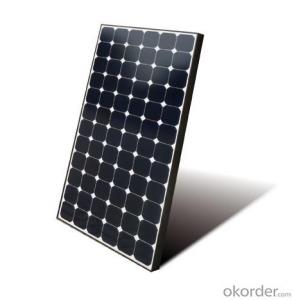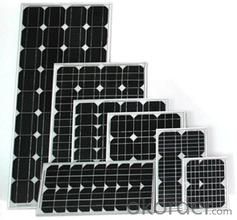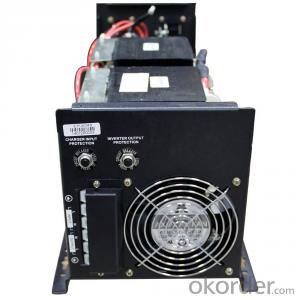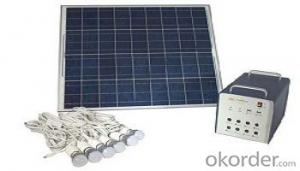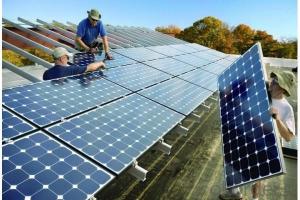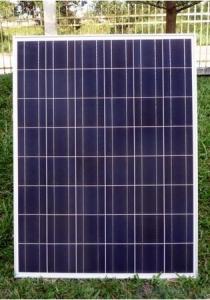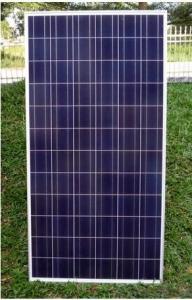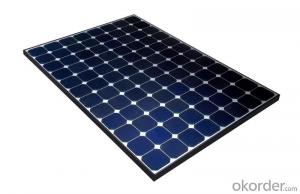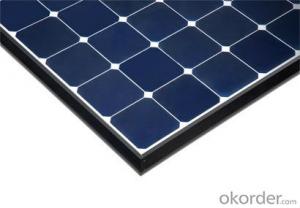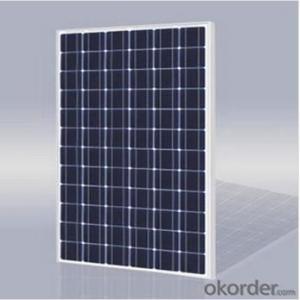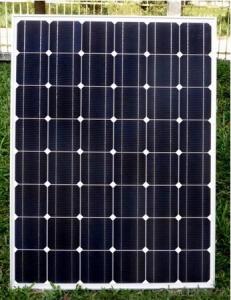Solar Energy Systems Peoria CNBM On Grid System 2000W with Certificate UL TUV CE
- Loading Port:
- Shanghai
- Payment Terms:
- TT OR LC
- Min Order Qty:
- 100 watt
- Supply Capability:
- 1000 watt/month
OKorder Service Pledge
OKorder Financial Service
You Might Also Like
Specification
CNBM On Grid System 2000W with Certificate UL TUV CE
Product description
They range from small residential and commercial rooftop systems to large utility-scale solar power stations. Unlike stand-alone power systems, a grid-connected system rarely includes an integrated battery solution, as they are still very expensive. When conditions are right, the grid-connected PV system supplies the excess power, beyond consumption by the connected load, to the utility grid.
Connection of the photovoltaic power system can be done only through an interconnection agreement between the consumer and the utility company. The agreement details the various safety standards to be followed during the connection.[4]
Systems such as Net Metering and Feed-in Tariff which are offered by some system operators, can offset a customers electricity usage costs. In some locations though, grid technologies cannot cope with distributed generation feeding into the grid, so the export of surplus electricity is not possible and that surplus is earthed.
Grid-connected PV systems are comparatively easier to install as they do not require a battery system.[1][6]
Grid interconnection of photovoltaic (PV) power generation systems has the advantage of effective utilization of generated power because there are no storage losses involved.[7]
A photovoltaic power system is carbon negative over its lifespan, as any energy produced over and above that to build the panel initially offsets the need for burning fossil fuels. Even though the sun doesn't always shine, any installation gives a reasonably predictable average reduction in carbon consumption.
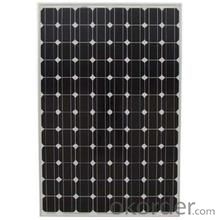
Application
Industrial
Commercial
Residential
Feature
Residential, grid-connected rooftop systems which have a capacity more than 10 kilowatts can meet the load of most consumers.[2] They can feed excess power to the grid where it is consumed by other users. The feedback is done through a meter to monitor power transferred. Photovoltaic wattage may be less than average consumption, in which case the consumer will continue to purchase grid energy, but a lesser amount than previously. If photovoltaic wattage substantially exceeds average consumption, the energy produced by the panels will be much in excess of the demand. In this case, the excess power can yield revenue by selling it to the grid. Depending on their agreement with their local grid energy company, the consumer only needs to pay the cost of electricity consumed less the value of electricity generated. This will be a negative number if more electricity is generated than consumed.[3] Additionally, in some cases, cash incentives are paid from the grid operator to the consumer.
Packaging
With carton and box
- Q: Can solar energy systems be used in areas with strict building codes or historical preservation restrictions?
- Yes, solar energy systems can be used in areas with strict building codes or historical preservation restrictions. In such cases, the installation of solar panels may require careful planning and compliance with specific guidelines to ensure architectural aesthetics and historical significance are preserved. This can be achieved through the use of alternative mounting options, such as ground-mounted or solar carport systems, that do not impact the building's exterior. Additionally, advancements in solar technology have allowed for the development of sleek and discreet panels that blend seamlessly with the surrounding architecture, making them more acceptable in historically preserved areas.
- Q: Can solar energy systems be used in areas with high altitude?
- Yes, solar energy systems can be used in areas with high altitude. In fact, solar panels can often be more efficient in high-altitude regions due to thinner air allowing for more direct sunlight and less atmospheric interference. However, it is important to consider factors like temperature, snowfall, and maintenance challenges that may arise in such areas.
- Q: Can solar energy systems be installed on religious institutions?
- Yes, solar energy systems can be installed on religious institutions. Many religious institutions have embraced solar energy as a sustainable and environmentally friendly solution to meet their energy needs. Installing solar panels on religious buildings not only helps reduce their carbon footprint but also allows them to save on electricity costs in the long run. Additionally, it aligns with the values of stewardship and care for the environment that many religious faiths promote.
- Q: Can solar energy systems be used in conjunction with backup generators?
- Solar energy systems can indeed be used alongside backup generators, resulting in a more reliable and efficient power supply. These systems capture energy from the sun and convert it into electricity, enabling the powering of homes, businesses, and other facilities. However, solar panels only generate electricity when sunlight is available, making them inadequate during cloudy days, nighttime, or power outages. This is where backup generators come into play. They are devices that supply electricity when the primary power source is insufficient or inaccessible, such as during blackouts or when solar energy systems fail to generate enough power. By integrating backup generators with solar energy systems, a continuous and dependable power supply is ensured, regardless of weather conditions or grid disruptions. During times when solar panels generate surplus electricity, they can charge batteries that store this energy for later use. These batteries can then be utilized to power the premises during periods of low solar production or high energy demand, reducing the need for the backup generator. However, in situations where extended cloudy days or prolonged power outages occur, the backup generator can activate to supply the necessary energy, ensuring that lights stay on and essential appliances continue to function. The combination of solar energy systems and backup generators provides the advantages of renewable energy and energy independence while also serving as a backup power source when required. This integration is particularly beneficial in areas with unreliable grid infrastructure or regions prone to natural disasters. Moreover, it allows for better energy management, potentially leading to reduced electricity costs and decreased reliance on fossil fuels.
- Q: What is the difference between a grid-tied and off-grid solar energy system?
- A grid-tied solar energy system is connected to the local utility grid, allowing excess electricity generated by the solar panels to be fed back into the grid. This system typically does not require batteries, as any shortfall in electricity can be supplemented from the grid. On the other hand, an off-grid solar energy system operates independently from the utility grid and relies on battery storage to store excess electricity for use during times when the panels are not producing enough power, such as at night or during cloudy days.
- Q: Can solar panels be installed on vertical surfaces?
- Indeed, it is possible to install solar panels on vertical surfaces. While the most commonly used and efficient method involves mounting solar panels on rooftops or tilted surfaces that face the sun, there are also specialized solar panels specifically designed for vertical installations. These solar panels, known as vertical or facade solar panels, are typically lightweight and frameless in design, making them easy to mount on vertical surfaces such as walls or building facades. Vertical solar panels are an excellent solution for buildings with limited roof space or for those who wish to maximize energy production on all available surfaces. However, it is important to note that vertical installations may not be as efficient as traditional rooftop installations due to the reduced exposure to sunlight. The performance of vertical solar panels can also be affected by the angle and orientation of the surface, as well as potential shading from nearby structures or trees. Nonetheless, advancements in solar technology and design have made vertical installations more practical and efficient than ever before. By carefully considering factors such as surface tilt, orientation, and shading, solar panels can be successfully installed on vertical surfaces, thus harnessing clean and renewable energy.
- Q: Can solar energy systems be used in areas with high levels of air pollution?
- Yes, solar energy systems can be used in areas with high levels of air pollution. Solar panels are designed to generate electricity from sunlight, regardless of the air quality. While air pollution can slightly reduce the efficiency of solar panels by blocking some sunlight, it does not render them completely ineffective. However, regular cleaning and maintenance of the panels may be required to ensure optimal performance in polluted areas.
- Q: How does the efficiency of solar panels vary across different angles of sunlight?
- Solar panels' efficiency is subject to variation across different angles of sunlight due to various factors. One crucial factor is the incident angle of sunlight. When sunlight strikes solar panels perpendicularly, they operate at their highest efficiency. Conversely, as the angle of sunlight becomes more oblique, the panels' energy output decreases. This decrease occurs because when sunlight hits the panel at an angle, it must travel a longer distance through the material, resulting in increased absorption and reflection, and reduced energy conversion. Another factor affecting solar panel efficiency is the implementation of tracking systems. Some solar panels feature tracking systems that allow them to accurately follow the sun's movement throughout the day, thereby optimizing the angle of incidence. By ensuring that the panels are consistently aligned with the sunlight, these tracking systems significantly enhance the efficiency of solar panels and maximize their energy output. Moreover, the type of solar cell technology used can also impact the efficiency of solar panels. Different types of solar cells display varying sensitivities to the incident angle of sunlight. For instance, monocrystalline silicon solar cells tend to exhibit higher efficiencies at steeper angles of sunlight compared to polycrystalline or thin-film solar cells. To summarize, the efficiency of solar panels can differ across various angles of sunlight due to factors such as incident angle, the presence of tracking systems, and the type of solar cell technology employed. Optimizing the angle of incidence and implementing tracking systems can effectively optimize the efficiency of solar panels and increase their energy output.
- Q: Can solar panels be used to power streetlights?
- Yes, solar panels can be used to power streetlights. Solar energy can be converted into electricity and stored in batteries, which can then be used to power the streetlights during the night. This renewable energy source is increasingly being employed to reduce reliance on traditional power grids and promote sustainability.
- Q: Can solar energy systems be used for powering outdoor surveillance cameras?
- Yes, solar energy systems can definitely be used for powering outdoor surveillance cameras. Solar energy systems consist of solar panels that convert sunlight into electricity, and this electricity can be used to power various devices, including outdoor surveillance cameras. By installing solar panels near the cameras, the captured sunlight can be converted into electrical energy, which can then be stored in batteries or used directly to power the cameras. This eliminates the need for traditional power sources or running electrical wires to remote locations, making it a cost-effective and eco-friendly solution. Additionally, solar energy systems can provide a reliable and continuous power source, even in areas with limited access to electricity, ensuring uninterrupted surveillance capabilities.
Send your message to us
Solar Energy Systems Peoria CNBM On Grid System 2000W with Certificate UL TUV CE
- Loading Port:
- Shanghai
- Payment Terms:
- TT OR LC
- Min Order Qty:
- 100 watt
- Supply Capability:
- 1000 watt/month
OKorder Service Pledge
OKorder Financial Service
Similar products
Hot products
Hot Searches
Related keywords
